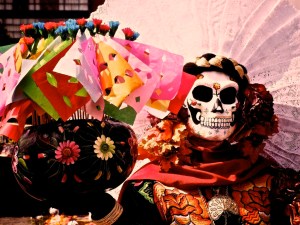Day of the Dead (Día de Muertos) is a major celebration in Mexico. It has roots in both Catholicism and pre Hispanic beliefs, and unlike death rituals in some parts of the world, is not a somber occasion. Quite the opposite: it is when family and friends welcome the return of deceased relatives and friends with offerings of traditional foods and other special items. Celebrants go to cemeteries to clean and decorate graves, and sometimes picnic in the cemetery or spend the night there. The actual Day of the Dead is November 2 but many communities celebrate for three days, with each day dedicated to different classes of dead, such as deceased children, adults, saints, etc. As traditions vary in the country and preparations occur during the month of October, there are many aspects of this important holiday which lack photographs on Wikimedia Commons, especially local traditions and cultural events.

As part of Wiki Loves Libraries, and ongoing efforts to incorporate authentic learning activities, the campus library of ITESM-Campus Ciudad de México sponsored a photography contest called Day of the Dead Wiki Style (Día de Muertos estilo Wiki). This event also coincided with the ITESM campus system’s “cultural month” activities held in October (Octubre Cultural).
Similar to Wiki Loves Monuments, there was an open period for the uploading of photos from 5 October to 5 November 2012, with photos going to a special category Día de Muertos estilo Wiki. A panel of judges in art, photography and cultural fields, including David Hernandez, scholastic director for the National Museum of Popular Cultures, were invited to participate as judges. On 15 November 2012, the winners of the Día de Muertos estilo Wiki photographic contest ([1]) were announced. The winners are Thetambourinekid with the best photograph (pictured [2]), Copetevic with the most original photograph ([3]) and Guilleminargp, who uploaded the most photographs. In total just over 400 photographs were uploaded and they can be seen here ([4]).
In addition to prizes, students were also encouraged to participate through a number of classes on campus that offered extra credit. One Chinese language class, taught by Lili Sun, had students take and upload photographs as an assignment, writing the descriptions in Spanish and Chinese (example), with a few adding other languages, such as French and German.
Due to the success of this project, plans are being made for a larger contest for the spring semester, this time focusing on traditions related to Holy Week and Easter in Mexico.
Leigh Thelmadatter, Regional Ambassador-Wikipedia Education Program
Spanish translation by Anmuratalla

Can you help us translate this article?
In order for this article to reach as many people as possible we would like your help. Can you translate this article to get the message out?
Start translation